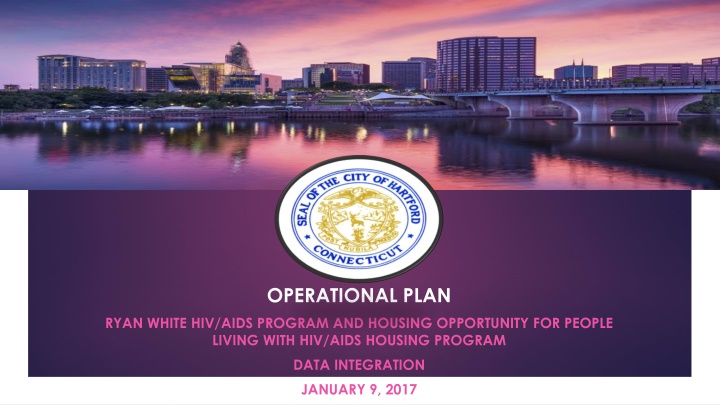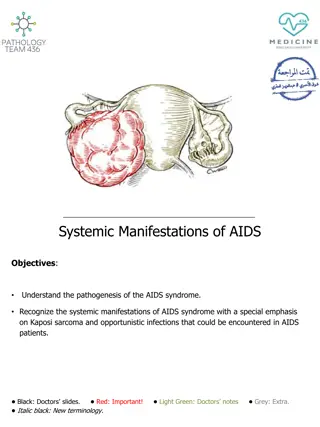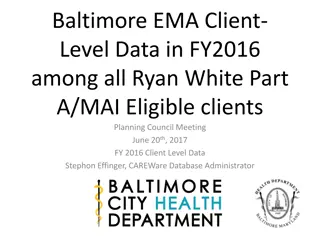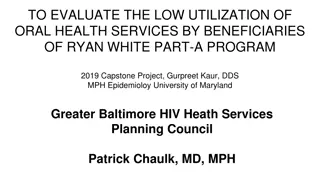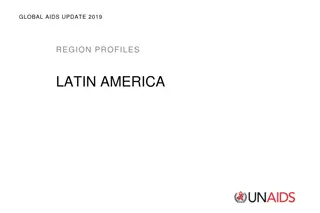Ryan White HIV/AIDS Program Data Integration Plan
This operational plan outlines the goals of the D.I.G. Project, aiming to enhance data exchange between the CAREWare and CaseWorthy systems for improved service delivery and analysis. The plan focuses on enacting new policies, creating interfaces, cross-training, analyzing health outcomes, and sharing best practices to enhance the support provided to persons living with HIV/AIDS and those at risk of homelessness. Key partners and the Data Integration Grant Steering Committee are also highlighted, emphasizing collaboration and data-driven approaches to improve health outcomes in Hartford and surrounding counties.
Download Presentation

Please find below an Image/Link to download the presentation.
The content on the website is provided AS IS for your information and personal use only. It may not be sold, licensed, or shared on other websites without obtaining consent from the author.If you encounter any issues during the download, it is possible that the publisher has removed the file from their server.
You are allowed to download the files provided on this website for personal or commercial use, subject to the condition that they are used lawfully. All files are the property of their respective owners.
The content on the website is provided AS IS for your information and personal use only. It may not be sold, licensed, or shared on other websites without obtaining consent from the author.
E N D
Presentation Transcript
OPERATIONAL PLAN RYAN WHITE HIV/AIDS PROGRAM AND HOUSING OPPORTUNITY FOR PEOPLE LIVING WITH HIV/AIDS HOUSING PROGRAM DATA INTEGRATION JANUARY 9, 2017
D.I.G Project Goals Enact new policies and processes to support data exchange and analysis; Create a bi-directional interface between the CAREWare and CaseWorthy systems; Develop and implement a cross training curriculum to foster improved service delivery, data exchange and analysis; Analyze comprehensive data to assess changes in health outcomes; Document and disseminate challenges, lessons learned, best practices, and innovative models. Improve health outcomes for persons living with HIV/AIDS and those prone to homelessness
Client Population Ryan White Part A Hartford HIV population & Hartford HOPWA clients who receives services in: Hartford County Middlesex County Tolland county.
Data Systems Ryan White CAREWare System (JPROG Inc.) HOPWA CaseWorthy System (Nutmeg Consulting)
Key Partners City of Hartford Ryan White and HOPWA recipient Offices AIDS CT, Connecticut Children s Specialty Group, Community Health Center Inc Chrysalis Center, Community Health Services Inc Charter Oak Health Center, Community Renewal Team, Hartford Gay and Lesbian Health Collective, Hands on Hartford, Human Resource Agency of New Britain, Latinos Community Services, Mercy Housing and Shelter, Rockville Hospital, Hospital of Central Connecticut, Hartford Hospital Saint Francis Hospital, St Phillips House, University of Connecticut Health Center Zezzo House
Data Integration Grant Steering Committee Peta-Gaye Nembhard Melissa Lebron Angelique Croasdale Danielle Warren-Diaz John Merz Yolanda Potter Melanie Alvarez Shawn Lang Lionel Rigler Catellia Casey Russ Cormier Abbie Kelly Kate Bassett Luna Jayna Hernandez Barbara Shaw Michelle Jarvis Sheryl Horowitz Ricardo Cruz
Interface Bidirectional Daily Imports/Exports of new data (if data is available) CaseWorhy will export housing data Housing status, veterans status, financial assessment, CM assignment etc CAREWare will export Clinical and service Information into CaseWorthy Medications, Labs, screenings, referrals, services, etc Alert/messaging system that allows users to send communications between systems
Reporting Performance Measurement Gaps in Care; Clients Prescribed HAART; Retention in Care and; Viral Load suppression. Custom Reporting demographics, service plan, housing data, referrals, utilization HOPWA CAPER (Improved) Ryan White RSR (Improved)
Client Flow Diagram CURRENT RYAN WHITE AND HOUSING SERVICE DELIVERY SYSTEM
Monitoring &Evaluation BY SHERYL HOROWITZ CHIEF RESEARCH AND EVALUATION OFFICER CONNECTICUT ASSOCIATION FOR HUMAN SERVICES
Research Question 1. How have client housing, care, and treatment outcomes for HOPWA and RW clients changed since both programs' providers began accessing integrated client data? Are changes equitable ? Data Collection Intervals* Outcome Measures RSR/CAPER element Data Source Housing Status: RSR % of RW clients unstably housed (disaggregated by race) % of HOPWA clients unstably housed (disaggregated by race) HousingStatusID Race/Ethnicity CAPER Housing Status Type of Residence/Living Situation Race/Ethnicity % of consumers with joint RW and HOPWA needs who achieve both viral suppression (or are engaging in ART)and stable housing (including transitional or emergency) within 4 months of receipt of case management RSR Retention in Care: % of RW and HOPWA clients who had at least one HIV medical care visit in each six-month period over the last 12 months, with a minimum of 60 days between medical visits(disaggregated by race) % of new HOPWA clients who had at least one HIV medical care visit in each six-month period over the last 12 months, with a minimum of 60 days between medical visits (disaggregated by race) ClientReportServic eVisits (ServiceID) ClientReportServic eDelivered (ServiceID) ClientReportAmbul atoryService (ServiceDate) Race/Ethnicity Baseline, 6m, 12m Sites integrated data systems RSR ART Use: % of RW and HOPWA clients prescribed ART for the treatment of HIV over the previous 12 months (disaggregated by race) % of new HOPWA clients prescribed ART for the treatment of HIV over the previous 12 months(disaggregated by race) Viral suppression: PrescribedArtID Race/Ethnicity RSR % of RW and HOPWA clients with a viral load <200 copies/mL during the last test in the last 12 months(disaggregated by race) % of new HOPWA clients with a viral load <200 copies/mL during the last test in the last 12 months(disaggregated by race) ClientReportViralLo adTest (ViralLoadTest Count ServiceDate) Race/Ethnicity
Research Question 2: In what ways has Ryan White and HOPWA data integration changed client service coordination across Ryan White and HOPWA providers? Data Collection Intervals* Data Source Outcome Measures RSR/CAPER element RW documentation of Housing Status: RSR # sites for which RW recipient has implemented collection of HOPWA housing status % of RW clients with housing status updated by RW MCM at least once in the last six months HousingStatusID CAPER Housing Status Type of Residence/Living Situation Joint RW and HOPWA clients: CAPER % of RW clients who are also HOPWA clients (have RW and HOPWA ID) Personal ID Project Entry Date # of RW clients who become new HOPWA clients # of RW and/or HOPWA clients with Gaps in Care Hartford-Data Interface Custom Report Baseline, 6m, 12m Sites integrated data systems Coordination of new unstably housed RW clients: RSR Average amount of time between date of entry of unstable client housing status into RW data system and date of HOPWA intake/enrollment Average amount of time between date of entry of unstable client housing status into RW data system and date of placement into stable housing Mean referrals/client/quarter (RW to housing services and HOPWA to RW) # Custom reports generated/site with RW and HOPWA variables HousingStatusID CAPER Housing Status Type of Residence/Living Situation Project Entry Date Destination Residential Move-In Date Referral type Custom Report Generation
Research Question 2: In what ways has Ryan White and HOPWA data integration changed client service coordination across Ryan White and HOPWA providers? (Cont d) RW and HOPWA program coordination # of RW and HOPWA joint program coordination meetings # of RW and HOPWA joint trainings RAND TA logs / Site progress reports 6m, 12m Perceived process of service coordination under old vs. new system List and descriptions of perceived barriers and facilitators List and descriptions of perceived effects of data integration and service protocol on coordination and client outcomes RW and HOPWA leadership, staff, provider, and expert client qualitative interviews Yr 2 and Yr 3 annual site visits Ability to use integrated data system to coordinate client services % of RW providers with housing-needs consumers, who request HOPWA data fields and reports/quarter % of HOPWA providers, with HIV/AIDS needs consumers, who request RW data fields and reports/quarter # of requests for additional fields or information within database % of staff with training who input data on a monthly basis Yr 2 and Yr 3 annual site visits Observation of provider use of the integrated data system Extent of use of the integrated data system Potential barriers to and facilitators of use (e.g., regarding training and positive and negative beliefs about the system). % Very Satisfied with training % of providers satisfied with data integration product and procedures Yr 2 and Yr 3 annual site visits Provider quantitative survey
Research Question 3: What specific aspects of data system changes (e.g., flags, alerts, provider-to-provider communication) have affected client housing, care, and treatment outcomes? Data Collection Intervals* Data Source Outcome Measures RSR/CAPER element Number and type of new data elements in integrated data systems: New data fields for housing in RW data system and/or new data fields for care and treatment in HOPWA data system New provider referral or communication functions in data system Prompts to contact RW clients who are out of care Prompts to contact HOPWA clients who are out of care Prompts for RW providers to check housing information Prompts for HOPWA providers to check care and treatment outcomes Sites integrated data system documentation: Codebooks/user manuals for RW and HOPWA data systems New data system functions (e.g., flags, alerts) Baseline, 6m Reported use of novel data elements and data system functions Perceived adequacy of training on data system and service coordination changes Perceived positive and negative aspects of use Perceived change in quality of service Perceived change in personal and medical progress Perceived change in value of process RW and HOPWA leadership, staff, and provider qualitative interviews Yr 2 and Yr 3 annual site visits Yr 2 and Yr 3 annual site visits Client focus groups or surveys
Research Question 4: In terms of cost, what resources are required to implement and maintain data integration of Ryan White and HOPWA data systems? Data Collection Intervals* Monthly Yr 2 and Yr 3 Outcome Measures RSR/CAPER element Data Source Site invoices Startup investment needed to launch the data integration Resources required to maintain the data integration Resources spent by categories of data integration activity Average cost of data integration per client served Staff time spent in labor categories (e.g., training, service coordination, supervision, reporting, etc.)(disaggregated by staff tenure) Financial data annual site visits Annual RW and HOPWA leadership and staff survey Yr 2 and Yr 3 annual site visits Hartford Research Question 5: What factors impact the implementation and efficiency of the integration of the Ryan White and HOPWA data systems? Data Collection Intervals* Data Source Outcome Measures RSR/CAPER element % of files w/o missing data elements Time from client event to data upload and availability (timeliness of data) % of clients who provide consent to RW and HOPWA System reports Sites integrated data systems Monthly Knowledge and confidence with new policies and procedures Identified barriers Identified Best Practices Coordination meetings/staff and leadership survey Yr 2 and Yr 3 annual site visits
Training AIDS CT Joint HOPWA & Ryan White Monthly CM Training Full Day Case Manager Training January 24, 2017 Joint HOPWA & Ryan White End User Training Tentatively February 2017
Thank You Peta-Gaye K. Nembhard, MS BA City of Hartford Dept. Health and Human Services DIG Project Coordinator 860-757-4705 nembp001@Hartford.gov
